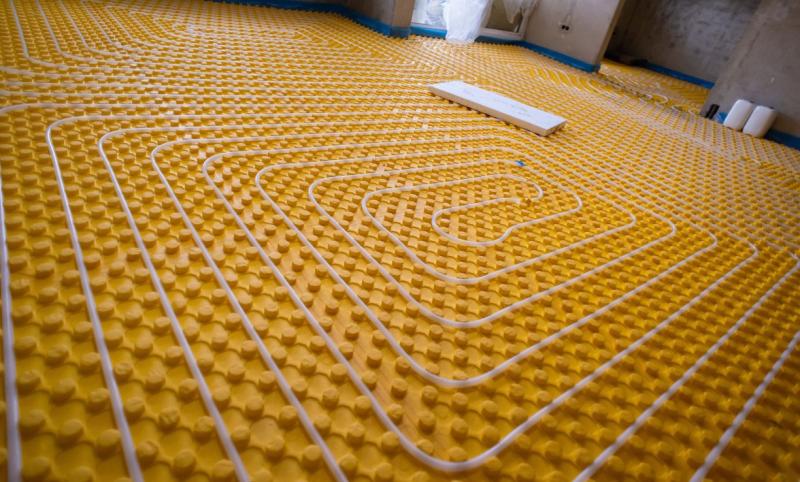Radiant Heating and Cooling: A Guide to Energy Efficiency

Radiant heating and cooling systems have gained significant popularity in recent years due to their potential for energy efficiency and improved comfort. Unlike traditional forced-air systems, which heat or cool the air, hydronic systems directly heat or cool objects and surfaces within a space. This unique approach offers several advantages in terms of energy consumption and overall comfort.
What is Radiant Heating and Cooling Systems?
Radiant heating and cooling systems are a type of HVAC (Heating, Ventilation, and Air Conditioning) system that works differently from traditional forced-air systems. Instead of heating or cooling the air in a space, radiant systems directly heat or cool objects and surfaces.
How it works:
- Radiant Heating: Radiant heating systems utilize a network of pipes embedded in floors, ceilings, or walls. Hot water or heated fluid is circulated through these pipes, warming the surrounding surfaces. These surfaces then radiate heat into the space, heating objects and people directly.
- Radiant Cooling: Radiant cooling systems work similarly, but with chilled water or fluid circulating through the pipes. This cools the surfaces, which in turn absorb heat from the surrounding environment, creating a cooling effect.
Benefits:
- Energy Efficiency: Radiant systems can be more energy efficient as they target specific areas, reducing wasted energy.
- Improved Comfort: They provide a more even heat distribution, eliminating hot spots and cold drafts.
- Better Air Quality: Since they don’t rely on air movement, they can reduce the circulation of allergens and pollutants.
- Zoned Control: Different areas can be heated or cooled independently, saving energy.
- Drawbacks:
- Higher Initial Cost: Installation can be more expensive than traditional systems.
- Maintenance: Regular maintenance is required to ensure optimal performance.
- Compatibility: Radiant systems may not be suitable for all buildings.
Overall, radiant heating and cooling systems offer a comfortable and potentially energy-efficient alternative to traditional HVAC systems.
Energy Efficiency of Radiant Systems
Radiant heating and cooling systems can be significantly more energy-efficient than traditional forced-air systems for several reasons:
- Targeted Heating and Cooling: Radiant systems heat or cool objects and surfaces directly, rather than heating or cooling the entire air volume of a space. This targeted approach reduces energy waste by only heating or cooling the areas that need it.
- Lower Operating Temperatures: Radiant systems can operate at lower temperatures than forced-air systems, which can lead to increased efficiency. Lower temperatures reduce heat loss and energy consumption.
- Reduced Drafts and Hot Spots: Forced-air systems can create drafts and hot spots, leading to uneven heating or cooling and increased energy consumption. Radiant systems provide a more even distribution of heat or coolness, reducing these issues.
- Improved Air Quality: Radiant systems do not rely on air movement to distribute heat or coolness, which can help to reduce the circulation of allergens and pollutants. This can improve indoor air quality and create a healthier environment.
- Zoned Control: Radiant systems can be zoned, allowing for different temperatures in different areas of a building. This can help to reduce energy consumption by only heating or cooling the areas that are in use. Heat Pump Installation Los Angeles
Factors Affecting Energy Efficiency
Several factors can influence the energy efficiency of radiant heating and cooling systems, including:
- System Design: The design of the radiant system, including pipe layout, insulation, and control systems, can significantly impact its energy efficiency.
- Building Envelope: The insulation and air tightness of the building envelope can affect how well the radiant system can maintain temperature and reduce heat loss or gain.
- Climate: The local climate can influence the energy requirements for heating and cooling, and the effectiveness of radiant systems in meeting those needs.
- Operating Conditions: Factors such as occupancy patterns, usage habits, and thermostat settings can affect energy consumption.
Considerations for Radiant Systems
While radiant heating and cooling systems offer many benefits, there are also some factors to consider:
- Initial Cost: Radiant systems can have a higher initial cost compared to traditional forced-air systems, due to the installation of pipes and other components.
- Compatibility: Radiant systems may not be compatible with all existing buildings or HVAC systems. Duct Installation Los Angeles
- Maintenance: Radiant systems require regular maintenance, such as flushing and balancing, to ensure optimal performance. Fire Protection System Los Angeles
Conclusion
Radiant heating and cooling systems can be highly energy-efficient and provide improved comfort compared to traditional forced-air systems. 1 By carefully considering factors such as system design, building envelope, climate, and operating conditions, homeowners and building owners can maximize the energy efficiency benefits of radiant systems
Comments